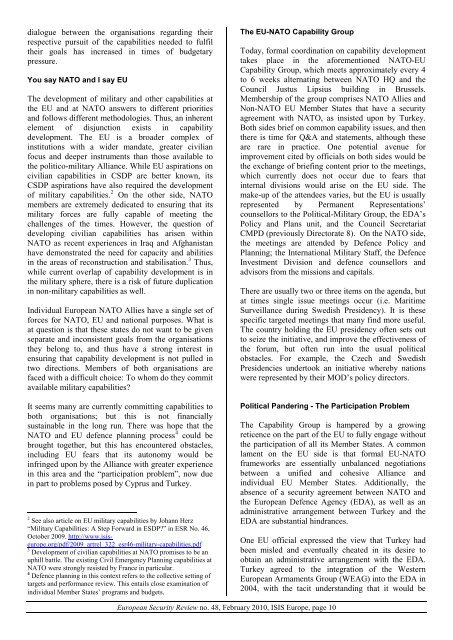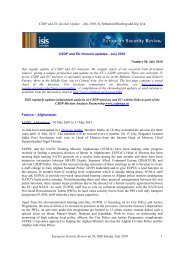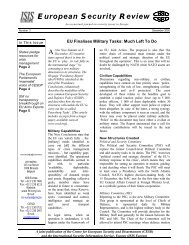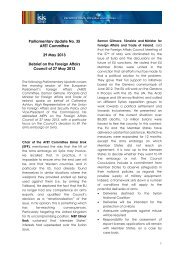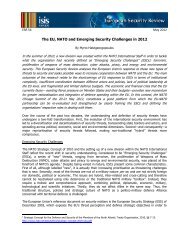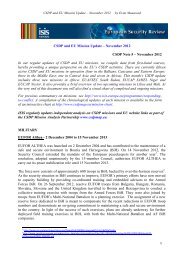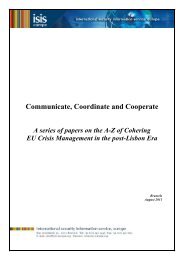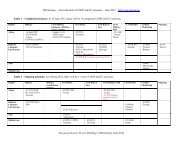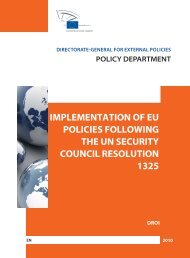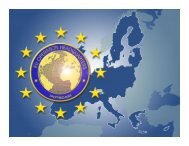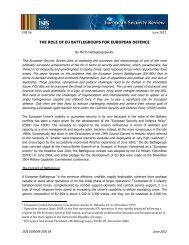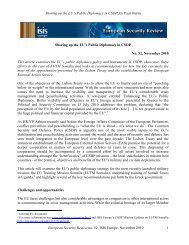ISIS Europe News In This Issue
ISIS Europe News In This Issue
ISIS Europe News In This Issue
You also want an ePaper? Increase the reach of your titles
YUMPU automatically turns print PDFs into web optimized ePapers that Google loves.
dialogue between the organisations regarding their<br />
respective pursuit of the capabilities needed to fulfil<br />
their goals has increased in times of budgetary<br />
pressure.<br />
You say NATO and I say EU<br />
The development of military and other capabilities at<br />
the EU and at NATO answers to different priorities<br />
and follows different methodologies. Thus, an inherent<br />
element of disjunction exists in capability<br />
development. The EU is a broader complex of<br />
institutions with a wider mandate, greater civilian<br />
focus and deeper instruments than those available to<br />
the politico-military Alliance. While EU aspirations on<br />
civilian capabilities in CSDP are better known, its<br />
CSDP aspirations have also required the development<br />
of military capabilities. 2 On the other side, NATO<br />
members are extremely dedicated to ensuring that its<br />
military forces are fully capable of meeting the<br />
challenges of the times. However, the question of<br />
developing civilian capabilities has arisen within<br />
NATO as recent experiences in Iraq and Afghanistan<br />
have demonstrated the need for capacity and abilities<br />
in the areas of reconstruction and stabilisation. 3 Thus,<br />
while current overlap of capability development is in<br />
the military sphere, there is a risk of future duplication<br />
in non-military capabilities as well.<br />
<strong>In</strong>dividual <strong>Europe</strong>an NATO Allies have a single set of<br />
forces for NATO, EU and national purposes. What is<br />
at question is that these states do not want to be given<br />
separate and inconsistent goals from the organisations<br />
they belong to, and thus have a strong interest in<br />
ensuring that capability development is not pulled in<br />
two directions. Members of both organisations are<br />
faced with a difficult choice: To whom do they commit<br />
available military capabilities?<br />
It seems many are currently committing capabilities to<br />
both organisations; but this is not financially<br />
sustainable in the long run. There was hope that the<br />
NATO and EU defence planning process 4 could be<br />
brought together, but this has encountered obstacles,<br />
including EU fears that its autonomy would be<br />
infringed upon by the Alliance with greater experience<br />
in this area and the “participation problem”, now due<br />
in part to problems posed by Cyprus and Turkey.<br />
2 See also article on EU military capabilities by Johann Herz<br />
“Military Capabilities: A Step Forward in ESDP?” in ESR No. 46,<br />
October 2009. http://www.isiseurope.org/pdf/2009_artrel_322_esr46-military-capabilities.pdf<br />
3 Development of civilian capabilities at NATO promises to be an<br />
uphill battle. The existing Civil Emergency Planning capabilities at<br />
NATO were strongly resisted by France in particular.<br />
4 Defence planning in this context refers to the collective setting of<br />
targets and performance review. <strong>This</strong> entails close examination of<br />
individual Member States’ programs and budgets.<br />
The EU-NATO Capability Group<br />
Today, formal coordination on capability development<br />
takes place in the aforementioned NATO-EU<br />
Capability Group, which meets approximately every 4<br />
to 6 weeks alternating between NATO HQ and the<br />
Council Justus Lipsius building in Brussels.<br />
Membership of the group comprises NATO Allies and<br />
Non-NATO EU Member States that have a security<br />
agreement with NATO, as insisted upon by Turkey.<br />
Both sides brief on common capability issues, and then<br />
there is time for Q&A and statements, although these<br />
are rare in practice. One potential avenue for<br />
improvement cited by officials on both sides would be<br />
the exchange of briefing content prior to the meetings,<br />
which currently does not occur due to fears that<br />
internal divisions would arise on the EU side. The<br />
make-up of the attendees varies, but the EU is usually<br />
represented by Permanent Representations’<br />
counsellors to the Political-Military Group, the EDA’s<br />
Policy and Plans unit, and the Council Secretariat<br />
CMPD (previously Directorate 8). On the NATO side,<br />
the meetings are attended by Defence Policy and<br />
Planning; the <strong>In</strong>ternational Military Staff, the Defence<br />
<strong>In</strong>vestment Division and defence counsellors and<br />
advisors from the missions and capitals.<br />
There are usually two or three items on the agenda, but<br />
at times single issue meetings occur (i.e. Maritime<br />
Surveillance during Swedish Presidency). It is these<br />
specific targeted meetings that many find more useful.<br />
The country holding the EU presidency often sets out<br />
to seize the initiative, and improve the effectiveness of<br />
the forum, but often run into the usual political<br />
obstacles. For example, the Czech and Swedish<br />
Presidencies undertook an initiative whereby nations<br />
were represented by their MOD’s policy directors.<br />
Political Pandering - The Participation Problem<br />
The Capability Group is hampered by a growing<br />
reticence on the part of the EU to fully engage without<br />
the participation of all its Member States. A common<br />
lament on the EU side is that formal EU-NATO<br />
frameworks are essentially unbalanced negotiations<br />
between a unified and cohesive Alliance and<br />
individual EU Member States. Additionally, the<br />
absence of a security agreement between NATO and<br />
the <strong>Europe</strong>an Defence Agency (EDA), as well as an<br />
administrative arrangement between Turkey and the<br />
EDA are substantial hindrances.<br />
One EU official expressed the view that Turkey had<br />
been misled and eventually cheated in its desire to<br />
obtain an administrative arrangement with the EDA.<br />
Turkey agreed to the integration of the Western<br />
<strong>Europe</strong>an Armaments Group (WEAG) into the EDA in<br />
2004, with the tacit understanding that it would be<br />
<strong>Europe</strong>an Security Review no. 48, February 2010, <strong>ISIS</strong> <strong>Europe</strong>, page 10


